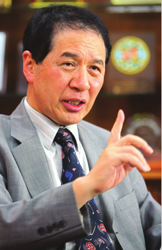Yongmin Kim: Setting the Pace for Bioengineers
By Jessica P. Johnson
NOTE: This is an overview of the entire article, which appeared in the January/February 2012 issue of the IEEE Pulse magazine.
Click here to read the entire article.
Early in his career, Yongmin Kim adopted an interdisciplinary approach to research that a more ego – driven researcher would have shied away from. He teamed with statisticians, electrical engineers, medical doctors, computer scientists, and industry executives to produce a steady stream of around 450 publications and a slew of innovations to medical imaging equipment that he has often had the pleasure of seeing put to use in hospitals in as short as two years. But Kim did not sit back and bask in his accomplishments. The moment he reached a goal, he set his sights on the next one. Having helped build the University of Washington’s Bioengineering Department, where he led students and faculty for 29 years, the IEEE Fellow and former Engineering in Medicine and Biology Society (EMBS) president resigned his tenured faculty position and set out to meet another challenge: serving as president of South Korea’s Pohang University of Science and Technology (POSTECH).
Kim’s academic drive and interest in bioengineering emerged at a very young age. “Around 1960,” says Kim, “my Dad brought a book from his school library about the submarine named Nautilus that went under the Arctic Circle without surfacing. It was the first nuclear-powered submarine in the world. I couldn’t read English at the time, so I just looked at the pictures – it was fascinating. I asked him how I could learn to do those kinds of things.”
“Electrical engineering,” was his father’s reply.
“I said, ‘Great, I want to be a professor in electrical engineering when I grow up.’ So at age seven or eight, I formed that goal in my life,” says Kim. It was the first of many high bars that Kim would set for himself.
His father encouraged his pursuit throughout elementary and high school and into the electrical engineering program at Seoul National University. There, Kim began to feel drawn to a slightly different discipline – bioengineering. “I was interested in how insects communicate with each other,” says Kim. “How do [lightning bugs] produce light? They don’t have any batteries inside. So I became interested in biomimetics and applying these techniques to medicine.”
Later, Kim pursued his Master’s and Ph.D. degrees at the University of Wisconsin, Madison. He accepted an offer from the University of Washington’s bioengineering program. Kim was soon to land research funding from a biomedical company for a project studying how to determine the optimal placement and power output of defribrillator paddles to minimize the risk of burns to the patient.
Kim went on to work extensively with industry during his tenure at the University of Washington. Focusing on next-generation ultrasound imaging systems, he partnered with companies like Texas Instruments, Hitachi Medical, Samsung, Siemens Medical, Canon, IBM, and Verathon.
Because of his collaborations, Kim now claims credit for more than 80 inventions, 70 patents, and 25 commercial licenses. Seeing his research used on a daily basis to improve the quality of patient treatment is one of Kim’s proudest achievements. But technology development was only half of Kim’s job. Improvement of his department and the quality of education its students received were equally important to him. Kim pioneered the University of Washington’s undergraduate program in bioengineering, which is now ranked one of the best in the nation. In 1996, his advances in the field earned Kim a distinction that had been another of his long-term goals – to become an IEEE Fellow.
Now, as POSTECH’s sixth president, Kim believes he can have a bigger impact in the field of research science by leading POSTECH’s large group of faculty and students. Being only 25 years old, the university has reached a high standing among other Asian universities and is poised to grow significantly through grants and industry partnerships in the next few years. Kim says he isn’t sure where he’ll end up after his presidency, but he is sure about one thing – that he’ll continue to advise students and colleagues engaged in bioengineering research.
ABOUT THE AUTHOR
Jessica P. Johnson (jpjsciencewriter@gmail.com) is a freelance science writer and a recent graduate of Boston University’s Center for Science and Medical Journalism.







